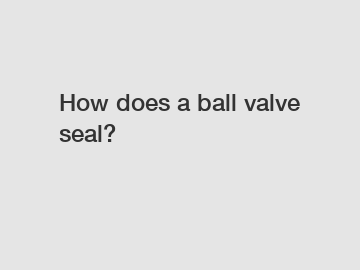Feb. 02, 2024
Mechanical Parts & Fabrication Services
HY contains other products and information you need, so please check it out.
How does a ball valve seal?
Ball valves are essential components used in various industries to control the flow of liquids or gases. They are popular for their durability, reliability, and ease of operation. One critical feature of a ball valve is its ability to seal tightly, preventing any leakage. In this article, we will explore how a ball valve achieves a proper seal, ensuring the efficient and safe operation of various systems.

1. The Basics of Ball Valve Design.
A ball valve consists of a spherical ball with a hole in the middle, called the bore. This ball is positioned within a valve body that has corresponding inlet and outlet ports. When the ball is aligned with the flow direction, the valve is open, allowing the flow of the medium. When the ball is rotated 90 degrees, the bore becomes perpendicular to the flow, resulting in the valve being closed.
2. The Role of Seat Materials.
To achieve a proper seal, ball valves incorporate seat materials. Seats are the sealing surfaces located between the ball and the valve body. Depending on the application, these seats can be made of different materials such as polytetrafluoroethylene (PTFE), reinforced PTFE, metal, or elastomers. These seat materials are chosen based on factors such as the type of medium, pressure, temperature, and chemical compatibility.
3. How the Ball Valve Seals.
When the ball valve is in the closed position, the seat material is compressed against the ball, creating a tight seal. This seal prevents any leakage from occurring. The compression of the seat material is achieved through the pressure applied by the valve body on the seat rings. This pressure ensures that the seat material conforms tightly to the ball's surface, eliminating any gaps or spaces where the medium could escape.
4. The Importance of Proper Installation.
While the design and materials are crucial for ensuring a proper seal, the installation of a ball valve also plays a vital role. Improper installation can lead to leakage and compromised sealing. It is essential to follow the manufacturer's instructions regarding the torque applied to the valve body during the installation process. This ensures that the necessary pressure is exerted on the seat material, achieving an effective seal.
5. Maintenance and Care.
To maintain the sealing capabilities of a ball valve, regular maintenance and care are necessary. This includes periodic inspections, lubrication, and cleaning. Over time, seat materials may wear out or become damaged, leading to leakage. Regular inspections allow for the detection of any potential issues and the replacement of worn-out parts. Proper lubrication of the valve stem and ball can also help reduce friction, ensuring smooth operation and maintaining the seal integrity.
In conclusion, a ball valve achieves a proper seal by using seat materials that tightly conform to the ball's surface. This sealing mechanism, along with proper installation and maintenance, ensures that the valve operates efficiently, preventing any leakage. Understanding the basics of ball valve sealing is crucial for industries that rely on these valves for fluid or gas control.
For more information or assistance with ball valves, feel free to contact us. We are experts in valve technology and can provide guidance on the best solutions for your specific needs.
The company is the world’s best China straight stop check valve company supplier. We are your one-stop shop for all needs. Our staff are highly-specialized and will help you find the product you need.
If you are interested in sending in a Guest Blogger Submission,welcome to write for us!
All Comments ( 0 )